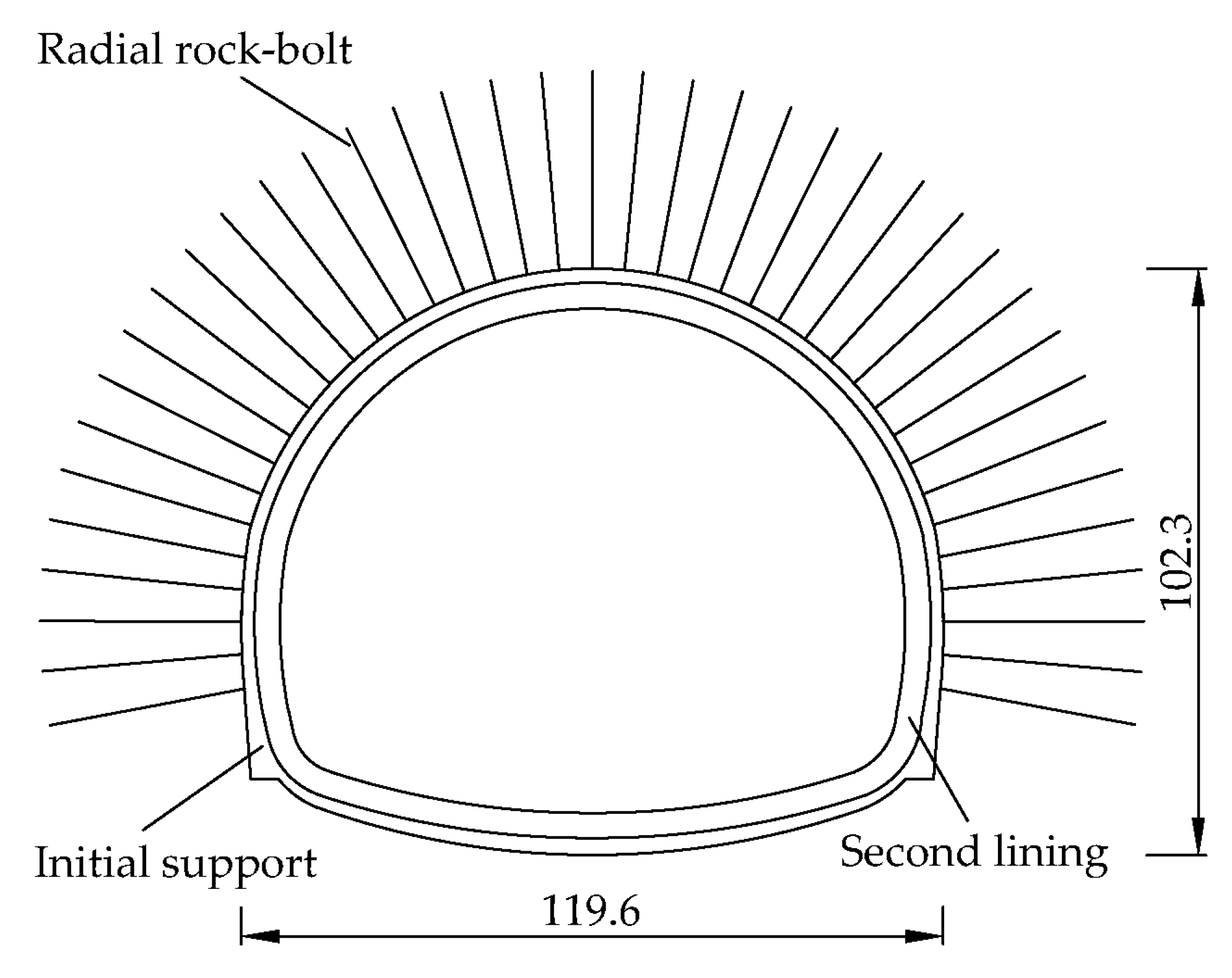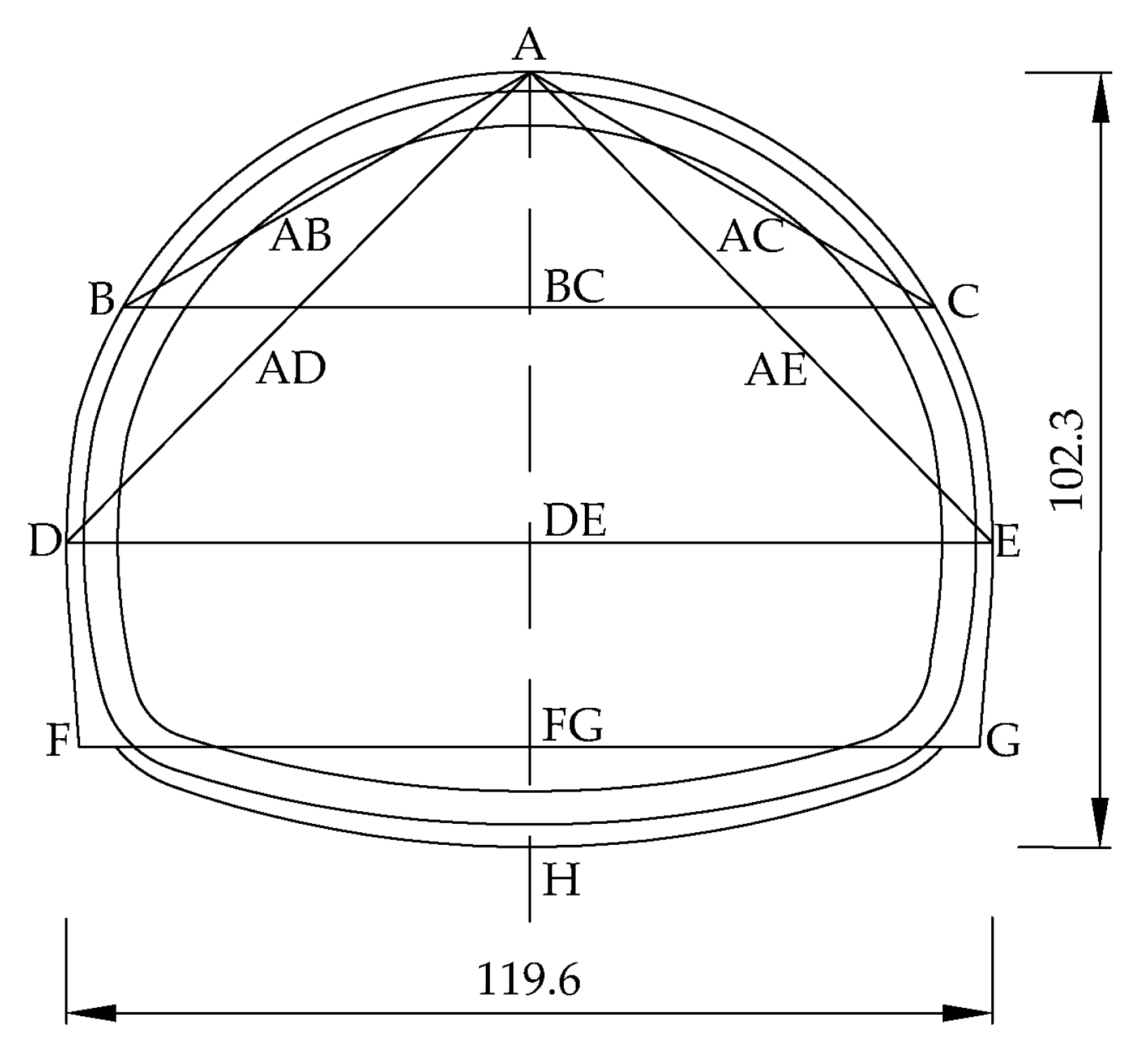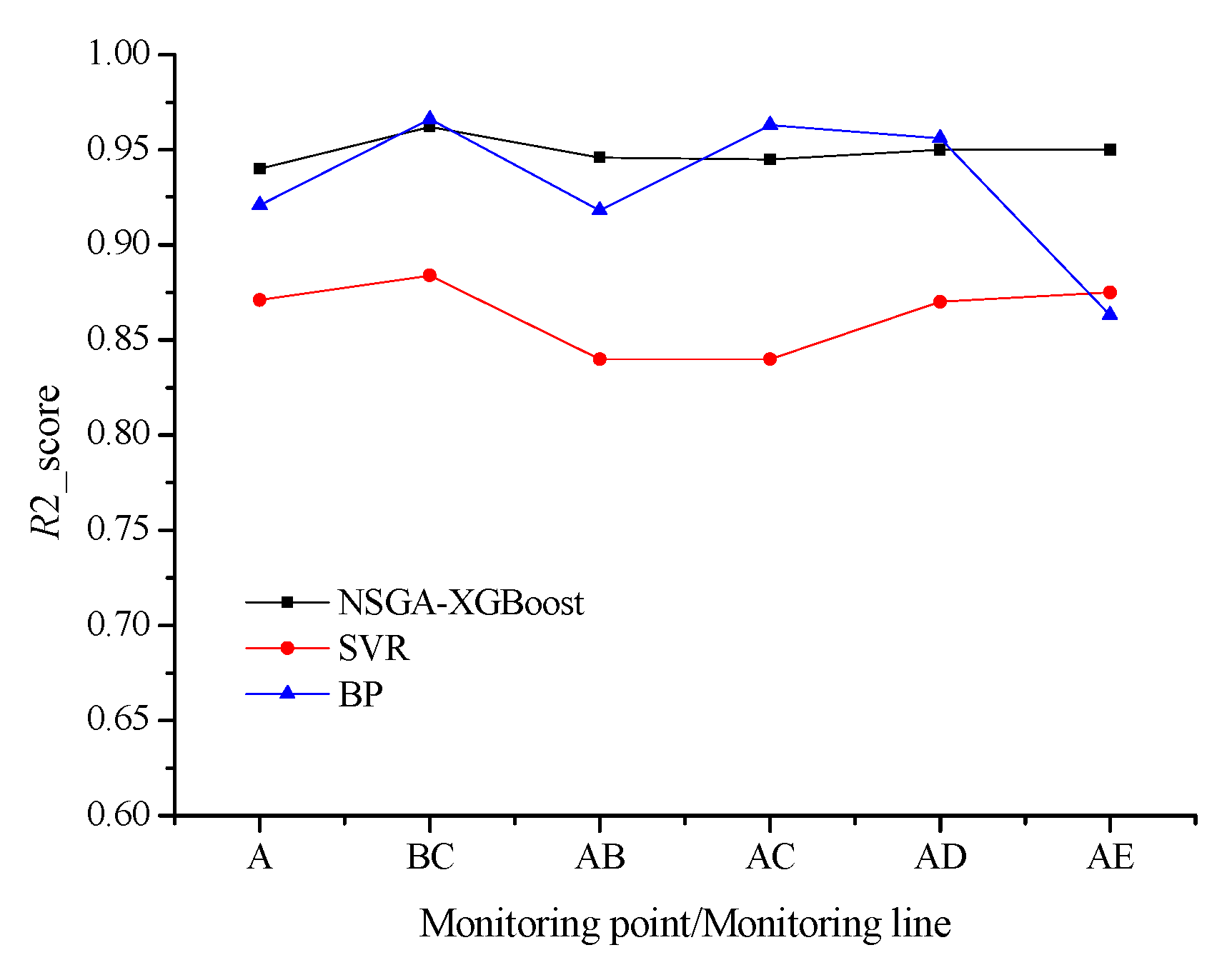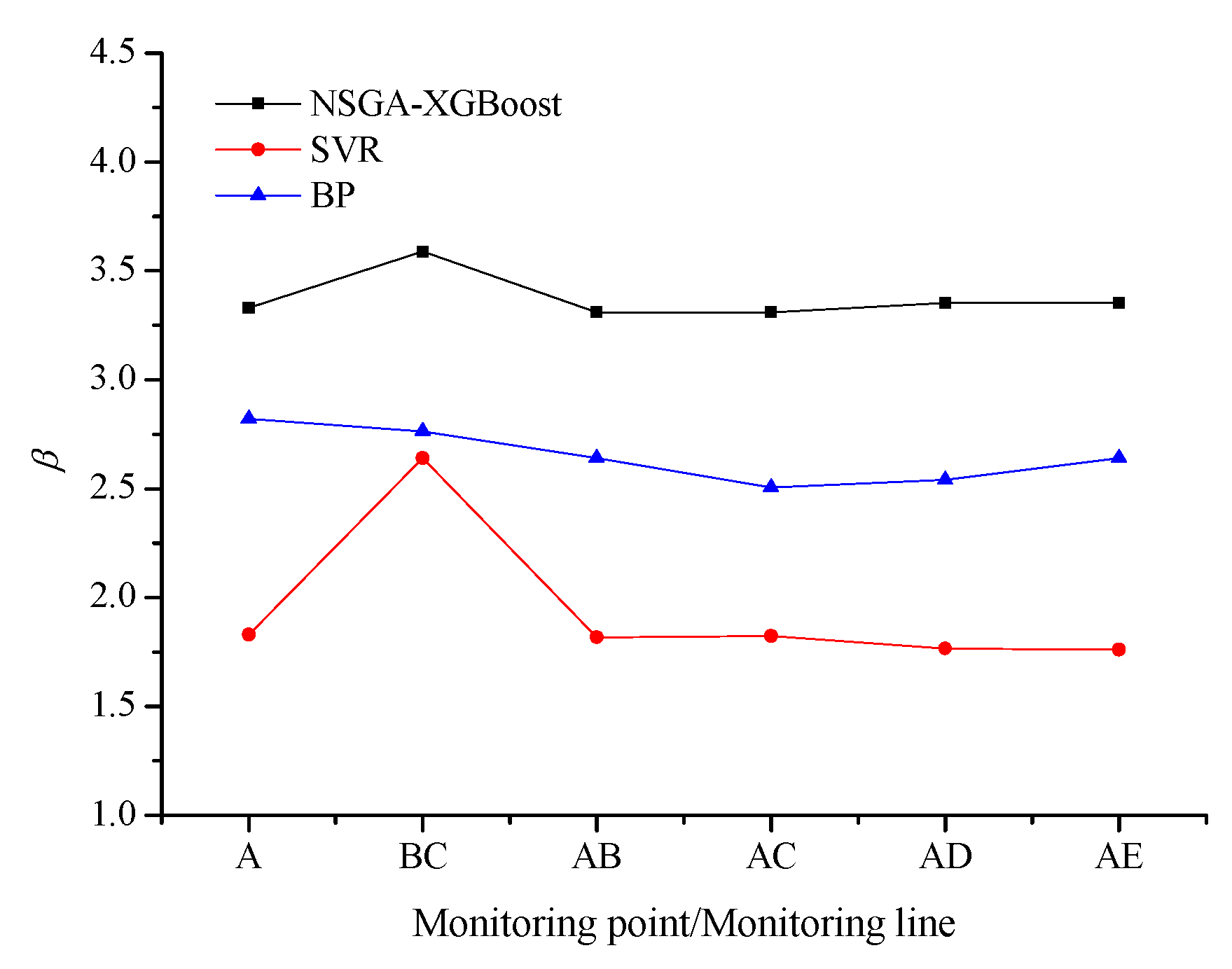NSGA–III–XGBoost-Based Stochastic Reliability Analysis of Deep Soft Rock Tunnel
Abstract
:1. Introduction
2. EXtreme Gradient Boosting (XGBoost)
- (1)
- Construct the objective function: additive model, forward step-by-step algorithm, objective function derivation and optimal solution.
- (2)
- The methods for constructing trees (splitting nodes) include precise greedy algorithms, approximate search algorithms, automatic processing of missing values, and setting learning rates.
| Algorithm 1. The exact greedy algorithm for split finding |
| Input: I, instance set of current node Input: d, feature dimension gain 0 , for to do , for in sorted (, by ) do , , end end Output: Split with max score |
| Algorithm 2. The approximate search algorithm for split finding |
| for to do Propose by percentiles on feature Proposal can be done per tree (global), or per split (local). end for to do end |
3. NSGA-III Algorithm
- (1)
- Obtain the offspring population from the mutation of the parent population , and then obtain the total population , assuming an empty population .
- (2)
- Perform non-dominated sort of to obtain the non-dominated layer .
- (3)
- Fill individuals in according to the order of non-dominated layers until they reach Layer . If and , proceed to Step (4); otherwise, if , .
- (4)
- Adaptive normalization is performed on the individuals in , calculating the distance between each individual and the reference line, and corresponding each individual to the reference point corresponding to the closest reference line, completing the reference point correspondence.
- (5)
- According to the corresponding results, the reference points are arranged in ascending order based on the number of individuals corresponding to each reference point. Individuals are selected from the reference points and added to with the priority given to the corresponding number of individuals. The iteration is repeated until the filling is completed.
- (6)
- Output .
| Algorithm 3. The NSGA-III algorithm |
| Input: structured reference points or provided aspiration points , parent population Output: . 1. 2. = Recombination + Mutation () 3. 4. = Non-dominated-sort () 5. repeat 6. and 7. until 8. Last front to be included: 9. if then 10. , break 11. else 12. 13. Points to be selected from : 14. Normalize objectives and create reference set : 15. Associate each member of with a reference point: % : closest reference point, : distance between and 16. Compute the niche count of reference point : 17. Choose members one at a time from to construct : 18. end if |
4. NSGA–III–XGBoost-Based Reliability Calculation Program Framework
4.1. Performance Function of Tunnel Initial Support Structure
4.2. XGBoost-Based Relationship between Geo-Mechanic Parameters and Displacement
4.3. NSGA–III–XGBoost-Based MCS Reliability Analysis
5. Case Study
5.1. Problem Description
5.2. Performance Function and Random Variables
5.3. Results and Discussion
5.3.1. Comparison of Tunnel Reliability Based on NSGA–III–XGBoost, SVR and BP
5.3.2. Comprehensive Reliability Index of Tunnel Initial Support Structure System
6. Conclusions
- For the tunnel initial support structure system with fewer failure elements, using the proposed NSGA–III–XGBoost–MCS method and the system reliability theory can estimate its failure probability range and determine its comprehensive reliability index.
- The calculation time of each forward construction finite difference simulation (FDS) (three-step construction method, excavation length 12 m, and each excavation length is 1 m) is about one hour, while the calculation time of the surrogate model is generally only 30~40 s. Using NSGA–III–XGBoost to establish the surrogate model of the nonlinear mapping relationship between geo-mechanical parameters and their responses can significantly reduce the time cost of numerical simulation calculations.
- A nonlinear mapping model with the interaction between rock mechanics parameters and displacement has been established. Then, by training the relevant XGBoost-based model to represent the displacement response model of the surrounding rock mechanical parameters, it has a lower computational cost and higher efficiency.
- There are the obvious advantages of the calculation stability and accuracy of the proposed method (NSGA–III–XGBoost–MCS) compared with SVR and BP.
Author Contributions
Funding
Institutional Review Board Statement
Informed Consent Statement
Data Availability Statement
Conflicts of Interest
References
- Zio, E. Reliability engineering: Old problems and new challenges. Reliab. Eng. Syst. Saf. 2009, 94, 125–141. [Google Scholar] [CrossRef]
- Liu, X.T.; Yu, X.G.; Tong, J.C.; Wang, X.; Wang, X.L. Mixed uncertainty analysis for dynamic reliability of mechanical structures considering residual strength. Reliab. Eng. Syst. Saf. 2021, 209, 107472. [Google Scholar] [CrossRef]
- Xu, Z.Y.; Saleh, J.H. Machine learning for reliability engineering and safety applications: Review of current status and future opportunities. Reliab. Eng. Syst. Saf. 2021, 211, 107530. [Google Scholar] [CrossRef]
- Low, B.K.; Einstein, H.H. Reliability analysis of roof wedges and rockbolt forces in tunnels. Tunn. Undergr. Space Technol. 2013, 38, 1–10. [Google Scholar] [CrossRef]
- Jafari-Asl, J.; Ben Seghier, M.E.; Ohadi, S.; Correia, J.; Barroso, J. Reliability analysis based improved directional simulation using Harris Hawks optimization algorithm for engineering systems. Eng. Fail. Anal. 2022, 135, 106148. [Google Scholar] [CrossRef]
- Ben Seghier, M.E.; Mustaffa, Z.; Zayed, T. Reliability assessment of subsea pipelines under the effect of spanning load and corrosion degradation. J. Nat. Gas Sci. Eng. 2022, 102, 104569. [Google Scholar] [CrossRef]
- Lü, Q.; Chan, C.L.; Low, B.K. System reliability assessment for a rock tunnel with multiple failure modes. Rock Mech. Rock Eng. 2013, 46, 821–833. [Google Scholar] [CrossRef]
- Wang, Q.; Fang, H.B. Reliability analysis of tunnels using an adaptive RBF and a first–order reliability method. Comput. Geotech. 2018, 98, 144–152. [Google Scholar] [CrossRef]
- Zhao, H.B.; Ru, Z.L.; Chang, X.; Yin, S.D.; Li, S.J. Reliability analysis of tunnel using least square support vector machine. Tunn. Undergr. Space Technol. 2014, 41, 14–23. [Google Scholar] [CrossRef]
- Zhao, H.B. High dimension model representation-based response surface for reliability analysis of tunnel. Math. Probl. Eng. 2018, 2018, 8049139. [Google Scholar] [CrossRef]
- Wang, Q.; Fang, H.B.; Shen, L. Reliability analysis of tunnels using a metamodeling technique based on augmented radial basis functions. Tunn. Undergr. Space Technol. 2016, 56, 45–53. [Google Scholar] [CrossRef]
- Feng, L.Y.; Zhang, L.M. Assessment of tunnel face stability subjected to an adjacent tunnel. Reliab. Eng. Syst. Saf. 2021, 205, 107228. [Google Scholar] [CrossRef]
- Li, T.Z.; Dias, D. Tunnel face reliability analysis using active learning Kriging model–Case of a two-layer soils. J. Cent. South Univ. 2019, 26, 1735–1746. [Google Scholar] [CrossRef]
- Do, D.P.; Tran, N.T.; Mai, V.T.; Hoxha, D.; Vu, M.N. Time–dependent reliability analysis of deep tunnel in the viscoelastic Burger rock with sequential installation of liners. Rock Mech. Rock Eng. 2020, 53, 1259–1285. [Google Scholar] [CrossRef]
- Liu, W.; Chen, E.; Yao, E.; Wang, Y.; Chen, Y. Reliability analysis of face stability for tunnel excavation in a dependent system. Reliab. Eng. Syst. Saf. 2021, 206, 107306. [Google Scholar] [CrossRef]
- Liu, H.; Low, B.K. System reliability analysis of tunnels reinforced by rockbolts. Tunn. Undergr. Space Technol. 2017, 65, 155–166. [Google Scholar] [CrossRef]
- Chakraborty, S.; Majumder, D. Hybrid reliability analysis framework for reliability analysis of tunnels. J. Comput. Civil Eng. 2018, 32, 04018018. [Google Scholar] [CrossRef]
- Langford, J.C.; Diederichs, M.S. Reliability based approach to tunnel lining design using a modified point estimate method. Int. J. Rock Mech. Min. 2013, 60, 263–276. [Google Scholar] [CrossRef]
- Su, Y.; Yang, M.H.; Su, Y.H.; Liang, B. Calculation for reliability of deep tunnel lining through optimization method of Kriging interpolation in collaboration with genetic algorithm. Rock Soil Mech. 2013, 34, 2661–2666. [Google Scholar]
- Ji, J.; Zhang, Z.; Wu, Z. An efficient probabilistic design approach for tunnel face stability by inverse reliability analysis. Geosci. Front. 2021, 12, 380–389. [Google Scholar] [CrossRef]
- Wang, Y.; Gao, Y.; Liu, Y. Bayesian–entropy gaussian process for constrained metamodeling. Reliab. Eng. Syst. Saf. 2021, 214, 107762. [Google Scholar] [CrossRef]
- Jerez, D.J.; Jensen, H.A.; Beer, M. An effective implementation of reliability methods for Bayesian model updating of structural dynamic models with multiple uncertain parameters. Reliab. Eng. Syst. Saf. 2022, 225, 108634. [Google Scholar] [CrossRef]
- Xu, J.C.; Jiang, Y.; Yang, C.B. Landslide displacement prediction during the sliding process using XGBoost, SVR and RNNs. Appl. Sci. 2022, 12, 6056. [Google Scholar] [CrossRef]
- Bui, H.G.; Cao, B.T.; Freitag, S.; Hackl, K.; Meschke, G.S. Surrogate modeling for interactive tunnel track design using the cut finite element method. Eng. Comput.–Germany 2023, 39, 4025–4043. [Google Scholar] [CrossRef]
- Jain, H.; Deb, K. An evolutionary many-objective optimization algorithm using reference-point based nondominated sorting approach, Part II: Handling constraints and extending to an adaptive approach. IEEE Trans. Evolut. Comput. 2014, 18, 602–622. [Google Scholar] [CrossRef]
- Chen, T.; Guestrin, C. XGBoost: A scalable tree boosting system. In Proceedings of the 22nd ACM SIGKDD International Conference on Knowledge Discovery and Data Mining, San Francisco, CA, USA, 13–17 August 2016; pp. 785–794. [Google Scholar]
- Zhou, J.; Qiu, Y.G.; Zhu, S.L.; Armaghani, D.J.; Khandelwal, M.; Mohamad, E.T. Estimation of the TBM advance rate under hard rock conditions using XGBoost and Bayesian optimization. Undergr. Space 2021, 6, 506–515. [Google Scholar] [CrossRef]
- Xu, J.C.; Wen, H.Y.; Sun, C.; Yang, C.B.; Rui, G.R. Numerical simulation of non-stationary parameter creep large deformation mechanism of deep soft rock tunnel. Appl. Sci. 2022, 12, 5311. [Google Scholar] [CrossRef]
- Deb, K.; Jain, H. An evolutionary many-objective optimization algorithm using reference-point-based nondominated sorting approach, Part I: Solving problems with box constraints. IEEE Trans. Evolut. Comput. 2014, 18, 577–601. [Google Scholar] [CrossRef]
- Jiang, P.; Wang, C.C.; Zhou, Q.; Shao, X.Y.; Shu, L.S.; Li, X.B. Optimization of laser welding process parameters of stainless steel 316L using FEM, Kriging and NSGA-II. Adv. Eng. Softw. 2016, 99, 147–160. [Google Scholar] [CrossRef]
- Ardakan, M.A.; Rezvan, M.T. Multi-objective optimization of reliability-redundancy allocation problem with cold-standby strategy using NSGA-II. Reliab. Eng. Syst. Saf. 2018, 172, 225–238. [Google Scholar] [CrossRef]





| Random Variables | Distribution | COV | ||
|---|---|---|---|---|
| Normal | 0.33 | 0.033 | 0.1 | |
| /° | Normal | 33 | 4.95 | 0.15 |
| /MPa | Normal | 350 | 50.5 | 0.144 |
| /kPa | Normal | 210 | 23 | 0.11 |
Disclaimer/Publisher’s Note: The statements, opinions and data contained in all publications are solely those of the individual author(s) and contributor(s) and not of MDPI and/or the editor(s). MDPI and/or the editor(s) disclaim responsibility for any injury to people or property resulting from any ideas, methods, instructions or products referred to in the content. |
© 2024 by the authors. Licensee MDPI, Basel, Switzerland. This article is an open access article distributed under the terms and conditions of the Creative Commons Attribution (CC BY) license (https://creativecommons.org/licenses/by/4.0/).
Share and Cite
Xu, J.; Sun, C.; Rui, G. NSGA–III–XGBoost-Based Stochastic Reliability Analysis of Deep Soft Rock Tunnel. Appl. Sci. 2024, 14, 2127. https://doi.org/10.3390/app14052127
Xu J, Sun C, Rui G. NSGA–III–XGBoost-Based Stochastic Reliability Analysis of Deep Soft Rock Tunnel. Applied Sciences. 2024; 14(5):2127. https://doi.org/10.3390/app14052127
Chicago/Turabian StyleXu, Jiancong, Chen Sun, and Guorong Rui. 2024. "NSGA–III–XGBoost-Based Stochastic Reliability Analysis of Deep Soft Rock Tunnel" Applied Sciences 14, no. 5: 2127. https://doi.org/10.3390/app14052127





